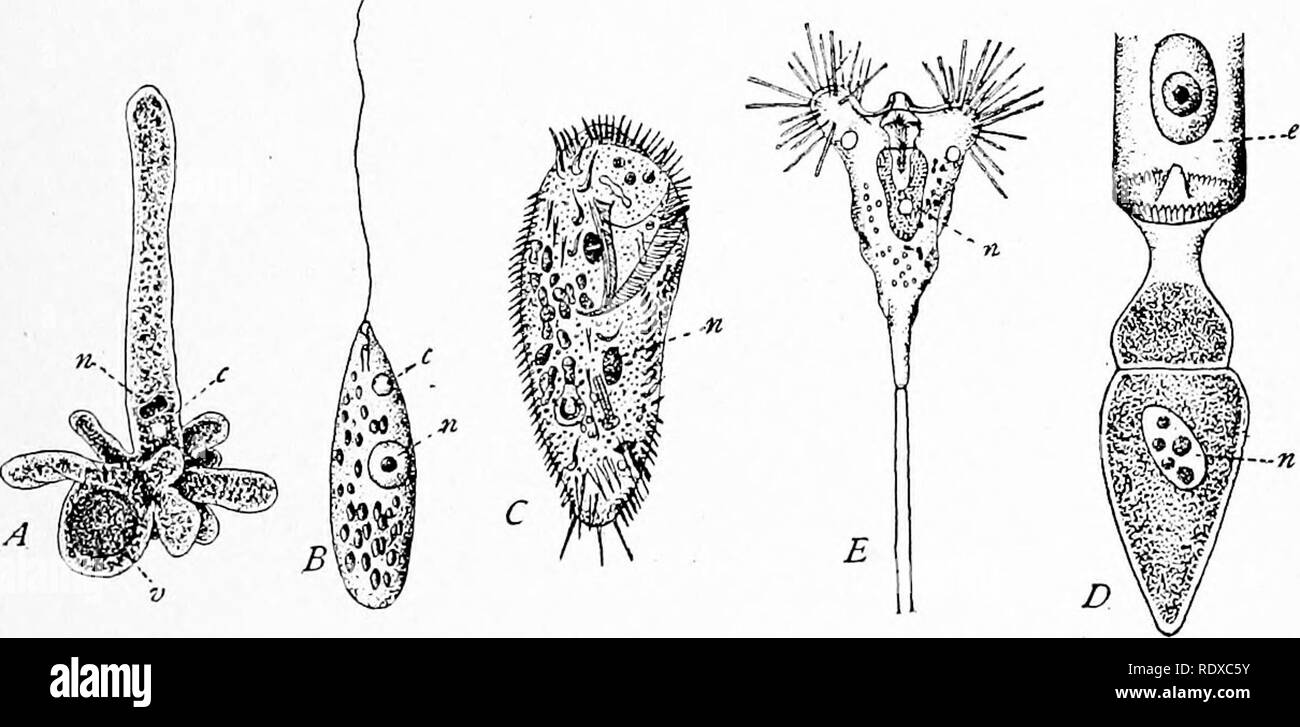. Protozoo?logy. Protozoa; Protozoa, Pathogenic. PPvOTOZOOLOGT T CHAPTEE I. GENERAL ORGANIZATION OF THE PROTOZOA. A PROTOZOON is a primitive animal organism usually consisting of a single cell, whose protoplasm becomes distributed among many free living cells. These reproduce their kind by division, by budding, or by spore formation, the race thus formed passing through different form changes and the protoplasm through various stages of vitality collec- tively known as the life cycle.^ Fig. 1. Types of protozoa. A, Ameba proteus, a rhizopod (after Calkins); B, Peranema trichoph- orum, a flagel

Image details
Contributor:
The Book Worm / Alamy Stock PhotoImage ID:
RDXC5YFile size:
7.1 MB (282.5 KB Compressed download)Releases:
Model - no | Property - noDo I need a release?Dimensions:
2256 x 1107 px | 38.2 x 18.7 cm | 15 x 7.4 inches | 150dpiMore information:
This image is a public domain image, which means either that copyright has expired in the image or the copyright holder has waived their copyright. Alamy charges you a fee for access to the high resolution copy of the image.
This image could have imperfections as it’s either historical or reportage.
. Protozoo?logy. Protozoa; Protozoa, Pathogenic. PPvOTOZOOLOGT T CHAPTEE I. GENERAL ORGANIZATION OF THE PROTOZOA. A PROTOZOON is a primitive animal organism usually consisting of a single cell, whose protoplasm becomes distributed among many free living cells. These reproduce their kind by division, by budding, or by spore formation, the race thus formed passing through different form changes and the protoplasm through various stages of vitality collec- tively known as the life cycle.^ Fig. 1. Types of protozoa. A, Ameba proteus, a rhizopod (after Calkins); B, Peranema trichoph- orum, a flagellate (after Biitschli); C, Stylonychia niytilis, a ciliate with specialized cilia (after Biitschli): E, Tokophrya quadripartita, a suotorian (after Biitschli); D, Pyxinia, sp., a poly- cystid gregarine with primite and deutomerite (after Wasielewsky); c, contractile vacuole; e, epithelial host cell; n, nucleus; v, food vacuole. It is quite impossible within the limits of a small volume to give a detailed or even adequate account of the many sides of interest of the unicellular animals. The wide range in habitat, from the purest waters of lake or sea to the foulest ditch, or the adaptation to environ- ments varying in character from a mountain stream to the semifluid substance of an epithelial nerve or muscle cell, has brought about 1 Definition by Calkins, 1906.. Please note that these images are extracted from scanned page images that may have been digitally enhanced for readability - coloration and appearance of these illustrations may not perfectly resemble the original work.. Calkins, Gary N. (Gary Nathan), b. 1869. New York and Philadelphia, Lea & Febiger